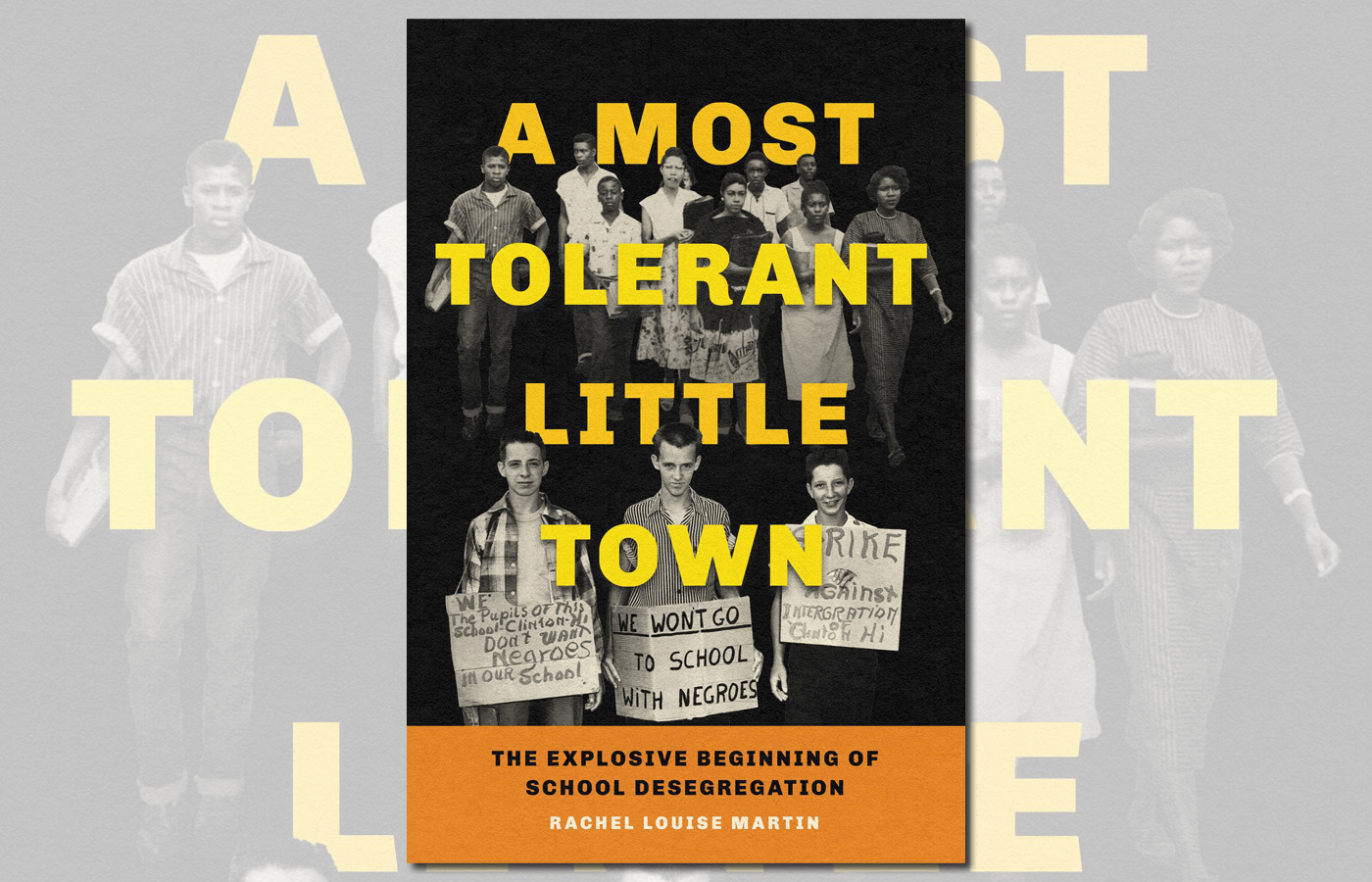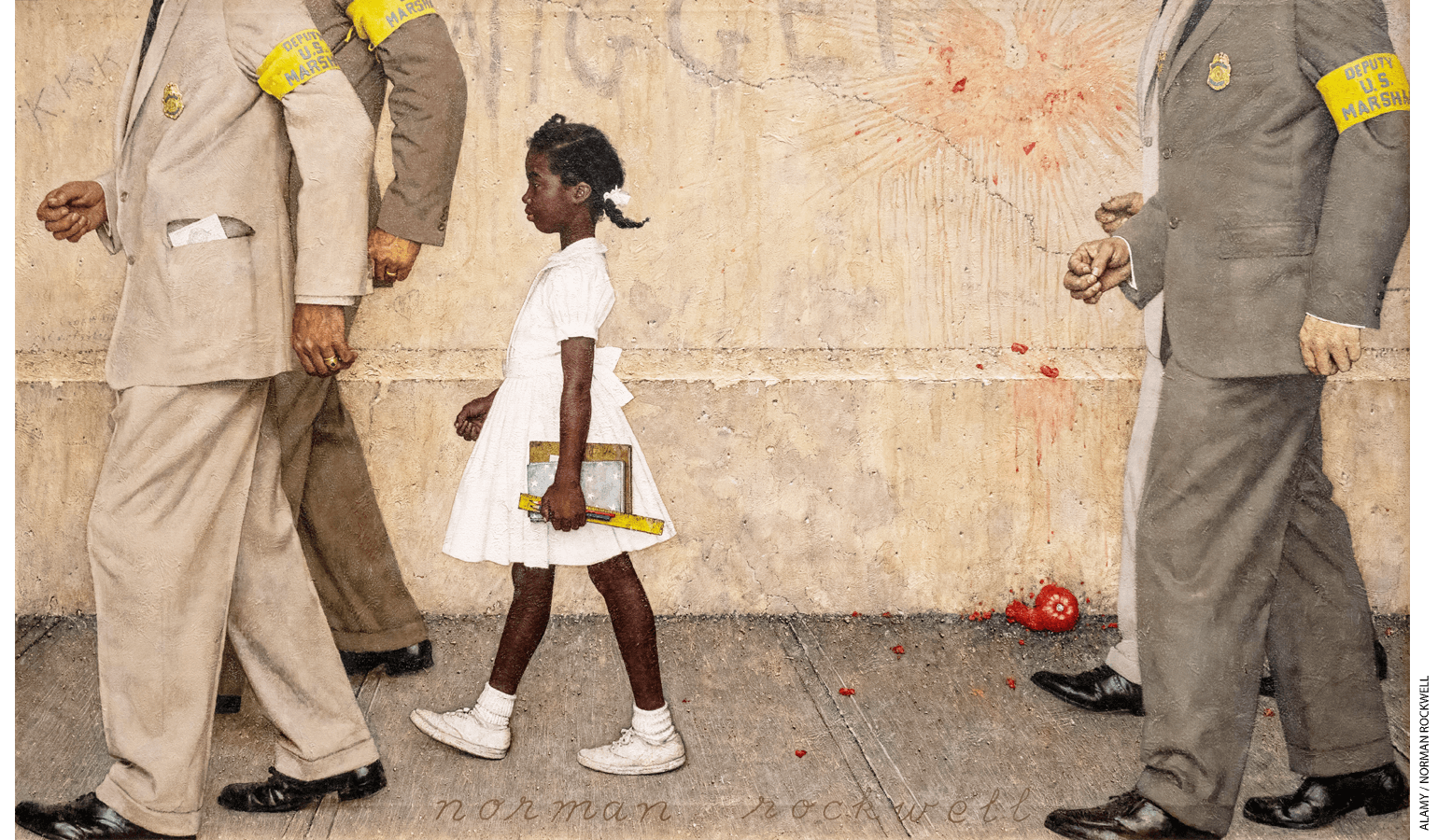
A Most Tolerant Little Town: The Explosive Beginning of School Desegregation
by Rachel Louise Martin
Simon & Schuster, 2023, $30; 362 pages.
As reviewed by Matthew Levey
We know of the nine Black students who bravely enrolled at Little Rock Central High School in the fall of 1957, despite the Arkansas governor’s attempts to bar them. Many recall Norman Rockwell’s portrait of first-grader Ruby Bridges walking past a wall splattered with a tomato and a scribbled racial slur on her way to William Frantz Elementary School in New Orleans in 1960. But the 1956 desegregation of Clinton High School in Anderson County, Tennessee, preceded both events. While it received extensive media coverage at the time, including photo essays in Look and an hour-long See it Now documentary by Edward R. Murrow, it has since been forgotten.
Rachel Louise Martin attended elementary school not far from Clinton. Researching in her university’s extensive civil rights archives for an oral history of the era, Martin was struck that Clinton was not mentioned once. With A Most Tolerant Little Town, she seeks to honor the 12 students and their families who led this early integration fight and to draw lessons for today’s reformers.
While the specifics are little known, the story is familiar. In 1950, Joheather McSwain and four other Black students sued Anderson County on the grounds that bussing them one hour away to a failing all-Black high school in a different county was separate and unequal. At trial they lost; white students, the judge said, were often bussed just as far. But in 1954, as McSwain’s appeal was winding through the Federal courts, the Supreme Court reached a decision on Brown v. Board of Education of Topeka, Kansas. In January 1956, a judge ordered Clinton High School to enroll Black students that fall, consistent with the mandate to desegregate with “all deliberate speed.

That August, 12 Black families risked their lives to integrate Clinton. They and their children faced unreconstructed racists who shouted slurs, burned crosses, and pressured politicians to preserve their “way of life.” Terrorists made bombs with dynamite stolen from local mines; luckily, some did not explode, but many did. And through it all, a handful of imperfect white leaders allied with the students to end segregation.
Martin centers A Most Tolerant Little Town on the students. For her, they are the ones who desegregated the school, not the lawyers, judges, and National Guardsmen. They did not seek martyrdom but simply wanted to be treated equally. Yet they saw many of their neighbors turn on them, both with vicious acts and by ignoring the injustice being perpetrated. The experience left them with what today we might call post-traumatic stress. “In a larger town,” Martin writes, “each faction could have retreated into their own community. . . . In Clinton this wasn’t possible, [so they] stopped talking about those years.”
But even as she elevates the bravery of the students, Martin acknowledges the critical role of three white leaders.
Born in 1899 in a tiny mining town in northeastern Tennessee, Federal Judge Robert Love Taylor was named for his uncle, a Union-supporting Tennessee governor. His father also served as governor. Like most white men of his era, Bob Taylor did not believe in racial equality, but he understood the primacy of the Brown decision. As Martin writes, Taylor
wished he could speak out, could tell everyone that yes, of course he believed in white supremacy. But the bench was to be above politics and personal convictions. . . . If the judge had spoken, he would have told everyone he agreed with the law-and-order white leaders in Clinton: integration might be bad, but lawlessness was worse.
Facing down slurs, taunts, and threats of violence, the 12 Black students enrolled at Clinton High in September 1956. Rather than work with principal D. J. Brittain Jr. to plan for the students’ safety, the school board mailed a letter to the Justice Department abdicating responsibility for the events. (Celdon Medaris, a teacher and daughter of the former mayor, called them “pantywaists.”) This abdication “convinced the virulent segregationists that D. J. had a choice.” But unlike most of his neighbors, Brittain “had never believed the county would win” the McSwain lawsuit. As he saw it, “his only option was to obey the law, whether he agreed with it or not. And if he was going to obey the law, then he would do so with the efficiency with which he did everything else.”
A former football coach, Brittain told the high school team, “When you lose, you lose. You go ahead and play the game by the new rules.” In the months ahead, the football players, all white, proved valuable protectors of the Black students. The only explanation for Brittain’s “race traitorship” that the segregationists of Clinton could adduce was that he was a Jew.

A third ally to the students and their families was Paul Turner, the pastor of Clinton’s First Baptist Church. While he did not believe in racial equality either, he told his congregation, “It is important to be a Christian first and a segregationist second,” and he pleaded with Willard Tills, a leading white supremacist, to drop his activities. “I cannot see how a conscientious Christian can be part of mob violence.”
Instead, Tills dropped his membership in the church. In November, after Turner escorted the Black students to school one day, he was savagely beaten by a mob that included Tills. The following July, an all-white jury convicted Tills and six others on the first ballot, much to the surprise of most observers.
Bobby Cain, the only senior among the original 12 Black students to make it through the year, graduated in May. That September he began studying sociology at what is today Tennessee State University.
A month later, at 4:30 on a Sunday morning, terrorists blew up Clinton High School. A sloppy police investigation meant that the criminals were never caught. The school board traveled to Washington to ask President Eisenhower for rebuilding assistance, but he did not want to interrupt his bridge game. Department of Education officials offered $20,000 towards the $750,000 cost of a new school.
Brittain and Turner eventually left Clinton, to New York and Nashville, respectively. But the experience never left them. In the 1980s, they both committed suicide.
* * *
Johns Hopkins professor Yascha Mounk has noted our political polarization leads some to believe the situation is so desperate that the ends justify the means. We saw this in the acts of white supremacists who bombed schools, churches, and synagogues and murdered activists. More recently we have seen it in the twisted logic that led supporters of Donald Trump to assault the Capitol. But we also see it, Mounk writes, in intra-group demands for ideological purity. In a Manichean world, men with mixed motivations like Taylor, Brittain, and Turner get little sympathy.
Martin’s polemical conclusion, calling for “reconstructing every part of our society” and electing leaders “willing to intervene quickly and decisively whenever the vulnerable among us are at risk,” sits uneasily at the end of a well-researched history. But whether one agrees with her policy proposal, she has performed an important service by acknowledging the absurdity of demanding perfection from our friends and allies. “When we tell people they do not belong in our movement, that they must go out . . . and do the internal work before they can be of use to us,” she writes, “we are ignoring the ways actions themselves can invoke internal change.” Like us all, Judge Taylor, Principal Brittain, and Reverend Turner were imperfect. But their recognition that our democracy places no one above the law is a lesson as needed today as it was in 1956.
Matthew Levey founded the International Charter School and writes on K–12 education.
This article appeared in the Summer 2024 issue of Education Next. Suggested citation format:
Levey, M. (2024). Tolerance in Tennessee: A compelling history of school integration considers the complexity of unlikely allies. Education Next, 24(3), 74-75.


